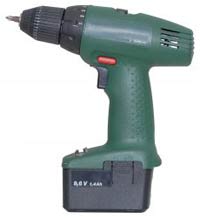Tools Designed for Securing Tools
An inside look at how DEWALT used machine-to-machine technology to tackle the $1 billion problem of jobsite theft
- By Mike Marett
- Aug 01, 2008
 There are two "S"s critical to the construction industry: safety and security. Protecting workers from harm is obviously of primary concern, but protecting assets on the jobsite against theft is also on the top of one's mind.
There are two "S"s critical to the construction industry: safety and security. Protecting workers from harm is obviously of primary concern, but protecting assets on the jobsite against theft is also on the top of one's mind.
Nobody knows this better than DEWALT. The company is one of the leading manufacturers of industrial power tools, offering more than 300 power-tool and equipment products, as well as 800 power-tool accessories.
DEWALT surveyed more than 1,500 construction professionals and found that jobsite security was the number one concern among construction industry end-users and buyers of its products. The study showed that:
• 97 percent of construction professionals were concerned about jobsite theft, which causes losses of more than $1 billion in the United States alone each year;
• more than 60 percent of those surveyed indicated that tool theft was their biggest concern, posing the greatest financial threat to their job profitability;
• more than 50 percent of the respondents reported that they had equipment stolen from a jobsite within the past 12 months;
• and more than 77 percent had experienced a theft up to five times each year over the past three years.
With a long-standing track record of providing tools to the construction industry, DEWALT wanted to find a way to solve the theft problems plaguing its customers. One of the most promising technologies it explored was wireless tracking.
DEWALT looked to M2M provider Numerex to develop and market comprehensive security solutions for the construction industry. Numerex brought an extensive cache of expertise in digital wireless security, network solutions, custom application interface design, a robust infrastructure and back-end services and support to the table. DEWALT brought its in-depth knowledge of the industry, and rugged, hardware components to Numerex and together the DEWALT SITELOCK™ was created to help eliminate the job-site theft problems that wreaked havoc in the construction industry.
SITELOCK, launched in 2005, is a portable security solution that wirelessly monitors equipment, work areas and storage buildings on the job site. When an intruder attempts to enter a secured area, disturb a secured piece of equipment or remove a sensor, an alarm is triggered and a wireless signal is sent immediately across the M2M network to alert the central monitoring station and designated end users. Construction company owners and designated employees receive actionable, real-time information that helps stop crimes in progress. With its simple installation and proven reliability, SITELOCK became a hit with customers, who quickly began reporting thwarted theft attempts and the apprehension of criminals caught in the act.
Building on the success of SITELOCK DEWALT and Numerex teamed up again to bring the benefits of digital GPS technology to construction job sites. The two companies developed a solution specifically designed to not only protect equipment on the job site, but also to track and recover missing job site assets. The new solution addressed a major problem facing the construction industry: time and money lost when equipment is stolen.
The resulting solution, DEWALT's MOBILELOCK™ GPS Locator with Anti-Theft Alarm, is a stand-alone, portable, rugged wireless location-based alarm system that is mounted to construction equipment. MOBILELOCK features a GPS locator that helps locate lost or stolen assets and transmits an alarm any time a protected piece of equipment is disturbed. By utilizing Numerex' SMSXpress™ gateway, alarm notifications are sent instantly to the central monitoring station and to designated users via phone or email. With Numerex's Networx™ 24/7 access and support, and real-time alarm message delivery, MOBILELOCK helps catch the bad guys and recover assets before they make it far from the job site.
Using Location Based Services (LBS) technology, MOBILELOCK provides accurate location tracking without the need for external antennas, even in impaired environments such as inside trailers and buildings. LBS technology leverages a device's physical location to provide location-relevant information to MOBILELOCK users. For example, high-value construction equipment misplaced, lost or stolen can be located with precise coordinates.
Reducing theft and vandalism on the job site offers immediate and positive financial impacts. Valuable assets are no longer lost; work remains uninterrupted, and insurance costs decline.
One company, which has deployed the new technology to protect and recover its valuable assets, is Altius Building Co. in Brookfield, Wisconsin. After starting a high-end building renovation, Altius' job site was frequently broken into. The company tried padlocks, security fencing and security cameras, but nothing worked. After four months and nine break-ins, resulting in thousands of dollars in lost tools and materials, Altius adopted the SITELOCK solution. In one week, Altius had the thief in hand -- and from the surveillance video it appeared they had the same thief responsible for past break-ins. The thief, who had used a ladder to obtain access to the second floor of the building, breaking a window and setting off a motion sensor on that floor, was caught by police, and Altius has been free from break-ins since.
Throughout the country, construction companies are deploying M2M technology to thwart the efforts of thieves and crime rings. They are now able to catch criminals red-handed and recover valuable assets quickly. Wireless solutions like those developed by DEWALT and Numerex play a key role in the construction industry's efforts to reduce theft and improve profitability. Without man hours lost on job site theft, construction companies can now focus on their most important assets -- their clients and the safety of their employees.